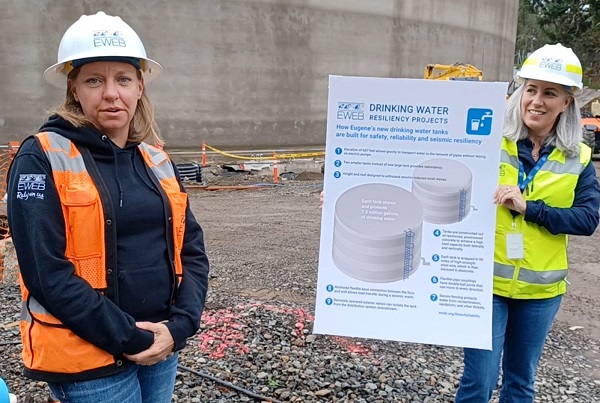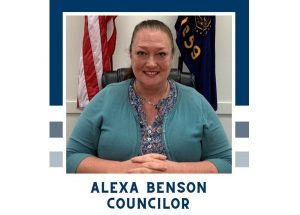EWEB water projects improve community resiliency during disasters
5 min read
by Aaron Orlowski, Eugene Water & Electric Board
EWEB is investing more than $200 million in major water infrastructure projects in the next 10 years with the goal of ensuring reliable water service even during a major natural disaster, such as an earthquake.
This week, EWEB participated in two national days of action: “The Great ShakeOut” earthquake drill and “Imagine a Day Without Water.” The overlap of the two events is significant because multiple major infrastructure projects EWEB is currently building or planning are specifically designed to withstand major earthquakes.
Scientists and state officials have been warning Oregonians about the threat of a major earthquake for years. According to Oregon officials, there is a 37% chance that an extreme, 7.1+ magnitude earthquake will strike the Pacific Northwest in the next 50 years. The quake would originate from the Cascadia Subduction Zone, where three ocean-based tectonic plates are sliding under the North American Plate, which underlies most of the continental U.S.
Scientists say that a major earthquake in the Cascadia subduction zone is overdue.
“We can’t take water for granted. Delivering clean, safe drinking water to about 200,000 people every day requires us to invest in resilient infrastructure across our entire system,” said Karen Kelley, EWEB’s chief operations officer. “Right now, that means upgrading water storage tanks and transmission pipelines based on known risks like the Cascadia Earthquake.”
An earthquake of the magnitude forecasted for the Pacific Northwest can produce as many as five to seven minutes of shaking and rolling. That movement creates significant challenges for water infrastructure. Water in storage tanks can form damaging slosh waves breaking through sidewalls and roofs. And underground pipes can be flexed unnaturally, leading to breakage. Such damage could lead to extended water outages.
It’s hard to imagine losing access to running water. Without it, there is nothing to drink, wash hands, brush teeth, or complete so many other activities essential to life and health. And without water, it’s not possible to provide sanitation services or fight fires.
To avoid catastrophic outages, EWEB is focused on reinforcing its “resilient spine” of water infrastructure. Construction of new, earthquake-resilient water tanks at East 40th Avenue is nearing completion. The hardening of a major transmission pipeline on Hilyard Street is also underway.
More water transmission projects are planned, including a major project spanning the Willamette River that will provide redundancy for water transmission from one bank to the other.
Next year, EWEB will begin seismic upgrades at College Hill. That project will include the demolition of the current, aged, rectangular reservoir so that resilient, round storage tanks can be built in its place. A new water transmission main will also be built with that project.
Fortifying this infrastructure is essential for avoiding a day, or – as history has shown is possible after major earthquakes – several weeks or even months without running water, if a disaster were to strike Eugene.
EWEB is making infrastructure earthquake resilient
EWEB is following the latest best practices in resilient infrastructure design.
New water storage tanks are constructed out of reinforced, prestressed concrete to achieve a high load capacity both laterally and vertically. The height and roofs of the tanks are designed to withstand earthquake-induced slosh waves. During construction, the tanks are wrapped with high-strength steel wire, which is then encased in shotcrete. Finally, the tanks are designed with a flexible base connection between the floor and wall that allows load transfer during an earthquake.
The piping connecting the tanks to the distribution system has flexible pipe couplings with double-ball joints that can move in every direction. And remotely operated seismic valves can isolate tanks from the distribution system downstream.
New, earthquake-resilient pipelines are constructed out of welded steel, which is the one of the most seismically robust materials available and can have a lifespan of over 100 years.
EWEB is improving resiliency with emergency wells, water stations
In addition to upgrading infrastructure, EWEB has set up emergency water distribution wells and operates two mobile treatment trailers to deploy in emergencies.
The emergency water stations are strategically located around the city. If a disaster strikes, the stations will be set up and pumps will draw water from underground wells so that residents will have an essential amount of water. EWEB has completed five water stations; two more are planned.
Eugene Springfield Community Emergency Response Teams (CERTs) are training to support EWEB in operating the emergency water stations.
EWEB also encourages customers to adopt resilient practices on their own. Customers can participate in EWEB’s Pledge to Prepare program, which guides them through creating an emergency preparedness kit and stockpiling enough water and food to last two weeks without basic services.
“It can sound cliché, but water really is life,” Karen said. “EWEB is taking these precautions so that in the event of a disaster, we will have the best chance at having water available for drinking and to put out fires, and to keep hospitals running.”
Read more about EWEB’s water resiliency efforts at https://www.eweb.org/waterreliability.
About the Eugene Water & Electric Board
The Eugene Water & Electric Board is Oregon’s largest customer-owned utility. Founded in 1911, EWEB provides water and electricity to approximately 96,000 customers in the Eugene-Springfield area. EWEB’s service area covers 236 square miles with a population of more than 200,000 people, including major institutions such as the University of Oregon. A five-member elected Board of Commissioners governs the utility, which does not operate to earn a profit or to serve the investment needs of stockholders.
Employing approximately 500 people, EWEB serves the people of Eugene by embodying core values of safety, reliability, affordability, environmental responsibility and community/culture. EWEB owns four energy generation facilities, including hydroelectric projects on the McKenzie and Clackamas Rivers, and leads watershed protection measures with local landowners and environmental organizations. With one of the greenest energy supplies in the nation, approximately 90% of EWEB’s power comes from carbon-free sources, and EWEB is committed to achieving a 95% carbon-free energy portfolio by 2030.
Image: Senior Engineer Laura Farthing and Chief Operations Officer Karen Kelley describe the two 7.5 million gallon water storage tanks nearing completion at the East 40th project site. Water Engineering Supervisor Wally McCullough and Communications Specialists Claire Wray and Aaron Orlowski also shared information about the historic project with local reporters Alan Torres (Register-Guard) and Noah Chavez (KEZI).




